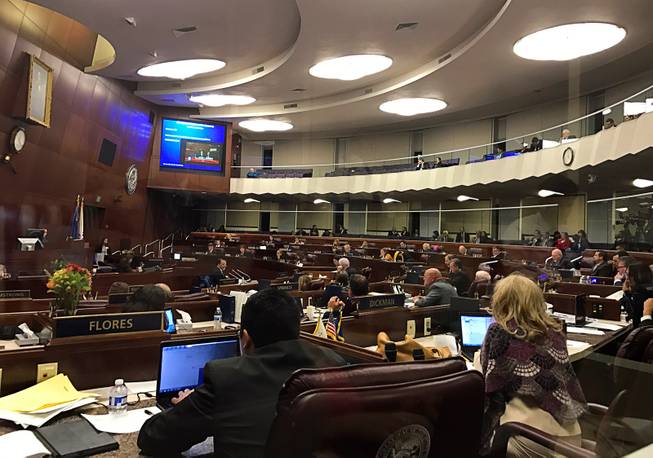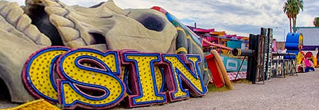
Lawmakers are shown during a special session in Carson City, early Friday, Oct. 14, 2016. The Senate voted to authorize public funds for an NFL stadium and convention center expansion in Las Vegas. Assembly members on Thursday were focused on a measure that would increase the hotel tax in Southern Nevada to fund a Las Vegas NFL stadium.
Sunday, June 28, 2020 | 2 a.m.
When Nevada lawmakers head to Carson City next month for a special session to consider how to address a $1.3 billion budget shortfall in the state budget, it won’t mark the first time members have been called into an emergency session. And it probably won’t be the last.
There have been 30 special sessions called in Nevada, with the first coming in 1867 — just three years after the state entered the union — and the most recent in 2016. Some of these sessions have been called almost immediately after the end of a regular session due to unfinished business.
Besides those called as a result of lawmakers running out of time to complete their work during a regular session, here’s a look at special sessions throughout the history of Nevada, starting with the most recent and working backward.
2016
Reason for the special session: Financing a football stadium for the Raiders and UNLV.
Result of the session: The state approved a 0.88% room tax increase to fund the $750 million public contribution to the $2 billion facility.
Update: The stadium is on track to be completed next month; the Raiders’ first season in Las Vegas is scheduled to begin in September.
2015
Reason: Providing tax breaks and other incentives to Faraday Future, an electric car company, in exchange for the company building a manufacturing plant in North Las Vegas.
Result: The state approved $335 million in tax breaks and incentives to the company to create the $1 billion facility.
Update: Faraday Future ceased development on the site in July 2017, and sold the site for almost $17 million in 2019.
2014
Reason: Providing tax breaks and other incentives to Tesla, an electric car company, in exchange for the construction of a $5 billion factory in Northern Nevada.
Result: The state approved $1.3 billion in tax incentives and breaks for the facility.
Update: The Tesla Gigafactory opened in 2016. The carmaker employs more than 7,000 people there, while Panasonic, which leases a portion of the facility, employs another 3,000 workers there.
2013
Reason: Consider raising taxes in Clark County to provide for more police officers.
Result: The state allowed the Clark County Commission to raise the county sales tax by .15% so Metro Police could hire an additional 150-200 officers. Among other bills passed in the session was $2 million approved for the Nevada Millennium Scholarship program.
Update: The Clark County Commission approved the “More Cops” sales tax increase in 2015. The increase went into effect in 2016.
2010
Reason: Addressing an approximately $890 million shortfall in general fund revenue caused by the Great Recession.
Result: Then-Gov. Jim Gibbons signed a bill that cut spending and raised taxes and fees. Lawmakers moved $200 million from state agencies’ reserve accounts to the general fund and approved another $300 million in budget cuts, including nearly $117 million cut from public school spending and $46 million from the Nevada System of Higher Education’s budget.
Update: The M Resort and the Clean Water Coalition sued the state, claiming a $62 million transfer from the coalition, a wastewater agency in Southern Nevada, was unconstitutional. The state Supreme Court agreed. The Clean Water Coalition is now defunct.
2008
Reason: Addressing a $340 million shortfall in general fund revenue for the biennium.
Result: In the less-than-nine-hour session, lawmakers cut $72.8 million from state budgets, shuffled around money and authorized borrowing up to $160 million from a local government investment fund.
2008
Reason: Addressing a $1.2 billion shortfall in general fund revenue for the biennium.
Result: Lawmakers approved the final $275 million in cuts needed to make up lost revenue after Gibbons had cut and moved around other funding sources.
2004
Reason: Impeachment proceedings against then-State Controller Kathy Augustine.
Result: Augustine was accused of using state staff and equipment on her re-election campaign in 2004. She was impeached by the Assembly and censured by the state Senate, and remained in office.
Update: Augustine was murdered by her husband, Chaz Higgs, in 2006.
2002
Reason: To consider legislation relating to medical malpractice insurance and capping the amount of damages that could be awarded in a malpractice lawsuit.
Result: Lawmakers placed a cap of $350,000, with exceptions for gross malpractice or a court finding of “exceptional circumstances,” on the amount of money plaintiffs could win for non-economic damages in malpractice lawsuits.
2001
Reason: To consider redistricting plans.
Result: A plan was approved that kept the Legislature at 21 senators and 42 Assembly members, approved a third congressional district, kept the Board of Education at 10 members and expanded the Board of Regents to 13 seats.
1989
Reason: To consider repealing legislation passed earlier in the year that drastically increased lawmakers’ retirement benefits.
Result: The legislation was repealed in a session that lasted just over two hours, the shortest special session in the state’s history.
1984
Reason: To consider statute changes regarding banks, banking and the extension of credit.
Result: Passed legislation that allowed bank holding companies based in another state to acquire a limited service bank in Nevada.
1968
Reason: To consider a plethora of topics, including authorizations and appropriations to some state agencies and land issues involving North Las Vegas and Las Vegas.
Result: Among other outcomes, land transfers between North Las Vegas and Las Vegas were approved. Clark County and the Hughes Tool Company, owned by reclusive billionaire Howard Hughes, were also allowed to enter into an agreement to begin work on a jet airport.
1966
Reason: To consider a plethora of topics, primarily educational needs both at the school district and university level, and including changes to the tax system.
Result: Parts of the state’s taxation system were changed, including uses for fuel and liquor taxes. Interestingly, LSD was also made illegal in this session.
1965
Reason: To reapportion the state’s legislative districts as ordered by a U.S. district judge who had found that the 1961 reapportionment was unconstitutional. At the time, 8% of the state’s population controlled 50% of the state Senate.
Result: Three seats were added to each legislative chamber, bringing the total members of the Senate to 20 and the Assembly to 40.
1964
Reason: To consider a plethora of issues, including school district financial problems, Lake Tahoe park lands and pollution in Lake Tahoe.
Result: The state Department of Conservation and Natural Resources was ordered to prepare a statewide outdoor recreation plan, and the session was an integral event in the state’s acquiring land for Lake Tahoe State Park.
1958
Reason: Allowing the state employment security department, in agreement with the federal secretary of labor, to provide payments under the Temporary Unemployment Compensation Act of 1958.
Result: Lawmakers created a temporary unemployment compensation repayment fund, which expired near the end of 1963.
1956
Reason: Adopting changes to the state public school system, among other issues.
Result: The state dissolved 208 school districts, replacing them with 17 districts that matched county boundaries.
1954
Reason: To consider revenue issues related to schools.
Result: The Nevada school survey committee was created, and it commissioned a study of the state’s K-12 education system.
1928
Reason: Amending the operation of the State Treasury and authorizing further funds for the Colorado River Commission, among other issues.
Result: Lawmakers sent $15,000 to the Colorado River Commission, and imposed some new duties upon the state treasurer.
1926
Reason: To consider legislation permitting transfers of public property for general benefit.
Result: County commissioners were allowed to return lands donated and dedicated for public purposes.
1920
Reason: To consider ratifying the 19th Amendment to the U.S. Constitution, which granted women the right to vote.
Result: Sadie Hurst of Reno, the first woman ever elected to the Assembly, presented the resolution to the Legislature. The Assembly ratified the amendment, with only one nay vote. The Senate voted unanimously to ratify the amendment.
1912
Reason: Authorizing a loan from the state school fund to the state general fund so that State Treasury transactions could continue on a cash basis.
Result: A $200,000 loan was authorized.
1908
Reason: Creating a security force to control a years-long labor dispute among union members and mining companies in Goldfield.
Result: Lawmakers approved legislation forming the Nevada State Police.
1867
Reason: In his message to the Legislature after convening the first special session, Gov. H.G. Blasdel urged lawmakers to devise “some measure of taxation, just to the people, and equal and uniform in its operation throughout the state … to enable the state to promptly meet the existing liabilities and current expenses for the next two years.”
Result: Over the course of the 20-day session, lawmakers approved nine bills and seven resolutions, covering topics including taxes, the sale of state lands and the Monroe Doctrine.

 Explore Las Vegas’ past and present
Explore Las Vegas’ past and present Boomtown: The Story Behind Sin City
Boomtown: The Story Behind Sin City Neon Boneyard: A 360° look
Neon Boneyard: A 360° look Mob Ties: See the connections
Mob Ties: See the connections Implosions: Classic casinos crumble
Implosions: Classic casinos crumble